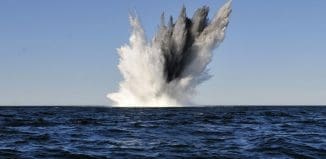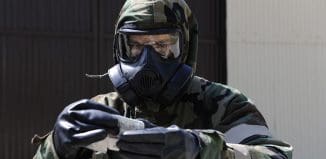- home
- News
- Technology
- Cyber
- HLS
- Innovation
- Unmanned
- Video
- Events
- Accelerators
- עברית
- Subscribe
- Contact Us
- home
- News
- Technology
- Cyber
- HLS
- Innovation
- Unmanned
- Video
- Events
- Accelerators
- עברית
- Subscribe
- Contact Us
Explosive Detection
Scientists Find Innovative Method for Remote Landmine Detection
Scientists from the Hebrew University in Jerusalem have developed a new system that uses a combination of lasers and glowing bacteria for unexploded ordnance...
New Explosive Detection Lab will Examine Innovative Technologies
The US Department of Homeland Security’s (DHS) Science and Technology Directorate (S&T) will provide independent testing, evaluation, and certification of explosives detection equipment for...
Widening Scope of Flight Sanctions Over Fear of Terrorist Attacks
An increase in security checks for flights from some Middle East airports was announced by Australia, though the country stopped short of implementing the...
Autonomous Surface Mine Countermeasure Tested Successfully
A comprehensive evaluation of a new autonomous surface mine countermeasure (SMCM) unmanned undersea vehicle (UUV) was successfully completed. The vehicle, Knifefish, was designed by...
Mystery – US Bans In-Flight Electronic Devices from Arab Countries
The US has been increasing the security arrangements regarding incoming flights - mainly from Muslim Middle Eastern states. Passengers arriving on direct flights from...
New Unmanned Mine Clearance and Explosive Disposal Platform
Wars in Afghanistan, Syria, Ukraine, Libya and Iraq have seen focus shift from traditional mine clearance to the disposal of booby traps and other...
Could Weapons-Grade Uranium Be Detected from Afar?
A technique for detecting enriched uranium with lasers could help regulators sniff out illicit nuclear activities from afar. Researchers from the University of Michigan...
No Need to Remove Shoes for Airport Security Checks
A new airport security technology developed. Amsterdam Airport Schiphol is to be the first to use new ultraviolet scanners, eliminating the need for passengers...
Weapon Detection Technology Developing In a New Direction
Hard Car Security, a firm from California, recently announced it plans to incorporate a built-in weapon detection system into the walls of client locations...
Explosives Detection – With Laser
The laser science and technology center (LASTEC) in New Delhi has developed a portable device which uses a laser beam to detect explosives in...
Robotic System Developed for Use in Underwater EOD Disposal
RE2 Robotics, a developer of robotic manipulator arms, has received a Phase II Small Business Innovation Research (SBIR) award to develop an inflatable Underwater...
Software-Based Spectral Sensing Will Support IED Detection
In recent years, an evolution has been taking place at the arena of military detection known as spectral sensing, with software-driven approaches emerging.
Spectral...
Forecast – Growth in Nano-Sensors CBRNE Detection Market
The market of sensor detection of toxic gases, bio toxins and explosives is expected to grow, finds Frost & Sullivan's TechVision team. This forecast...
New Bomb Disposal Robot to Neutralize Car Bombs
A new bomb disposal and tactical robot was launched recently. The Avenger Remotely Operated Vehicle (ROV) robot has been engineered to provide police and...
Chemical and Explosives Detectors – Autonomous Vehicles Compatible Kit
Some of the most dangerous threats encountered by the military, law enforcement, first responders and emergency personnel - like toxic, airborne chemicals - are often...
New Remote Chemical and Biological Threats Detector
ChemImage Sensor Systems (CISS) develops innovative chemical imaging sensors that address the landscape of drugs, chemical, biological and explosive (CBE) threats. The company has...
New Technology Mimicks Dogs’ Abilities to Detect Explosives
By mimicking how dogs use their smelling abilities, a team of government and university researchers have demonstrated “active sniffing” as a means to improve...
New Berlin Airport Aquires High Level Security
Many new security systems are developed for airports over the backdrop of the U.S. Safety Act which encourages companies to develop anti-terrorism technology. One...
New Landmine Discovering Force: Plants
A group of MIT engineers has converted ordinary spinach plants into biological bomb detectors.
The team, led by Michael Strano, implanted customised carbon nanotubes into...
Hitachi to Enter Counter-Terror Field
Hitachi announced that it will begin providing "walk-through type explosives trace detection system" for critical infrastructure facilities such as power plants and data centers...
Detector Can Identify Explosives Used in the Brussels Terror Attack
A non-radioactive, hand-held explosive threat detector, now has the additional capability to detect and identify TATP (Triacetone Triperoxide). This was the explosive substance used...
What Could be Detected with Bogus Bomb Detectors?
Pakistan continues to use bogus bomb detectors ADE-651 to guard its vital facilities such as airports and government installations despite being officially banned last...
Latest
Copyright © 2012 i-HLS. All Rights Reserved.











































